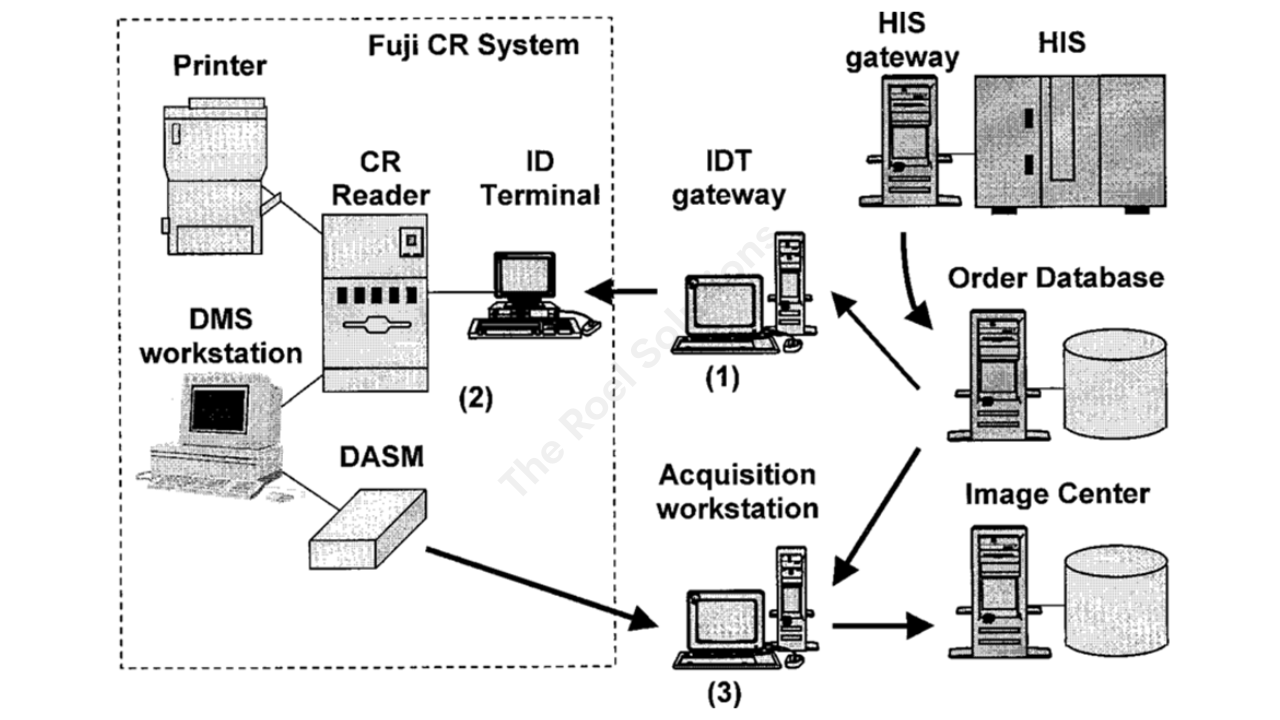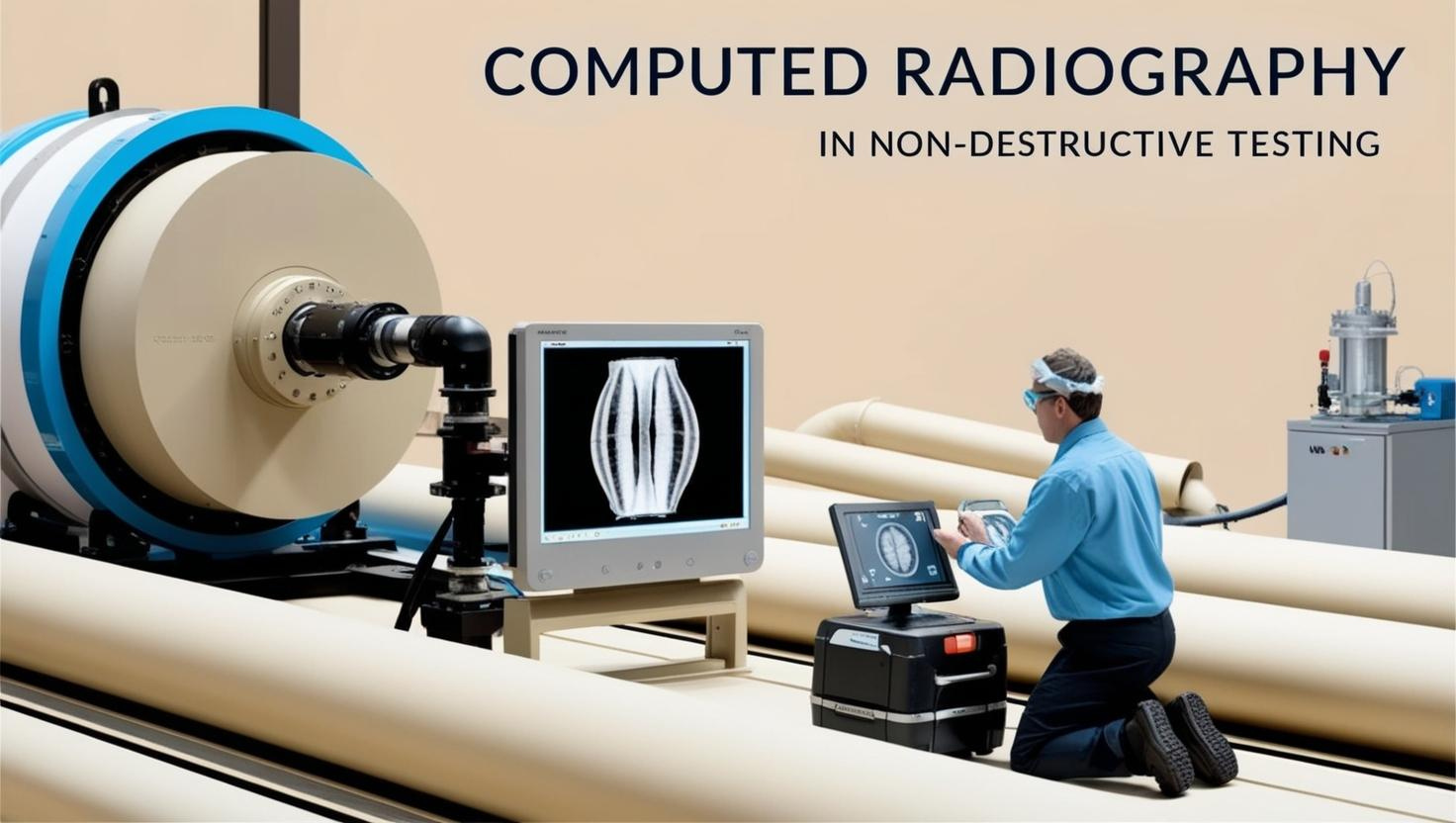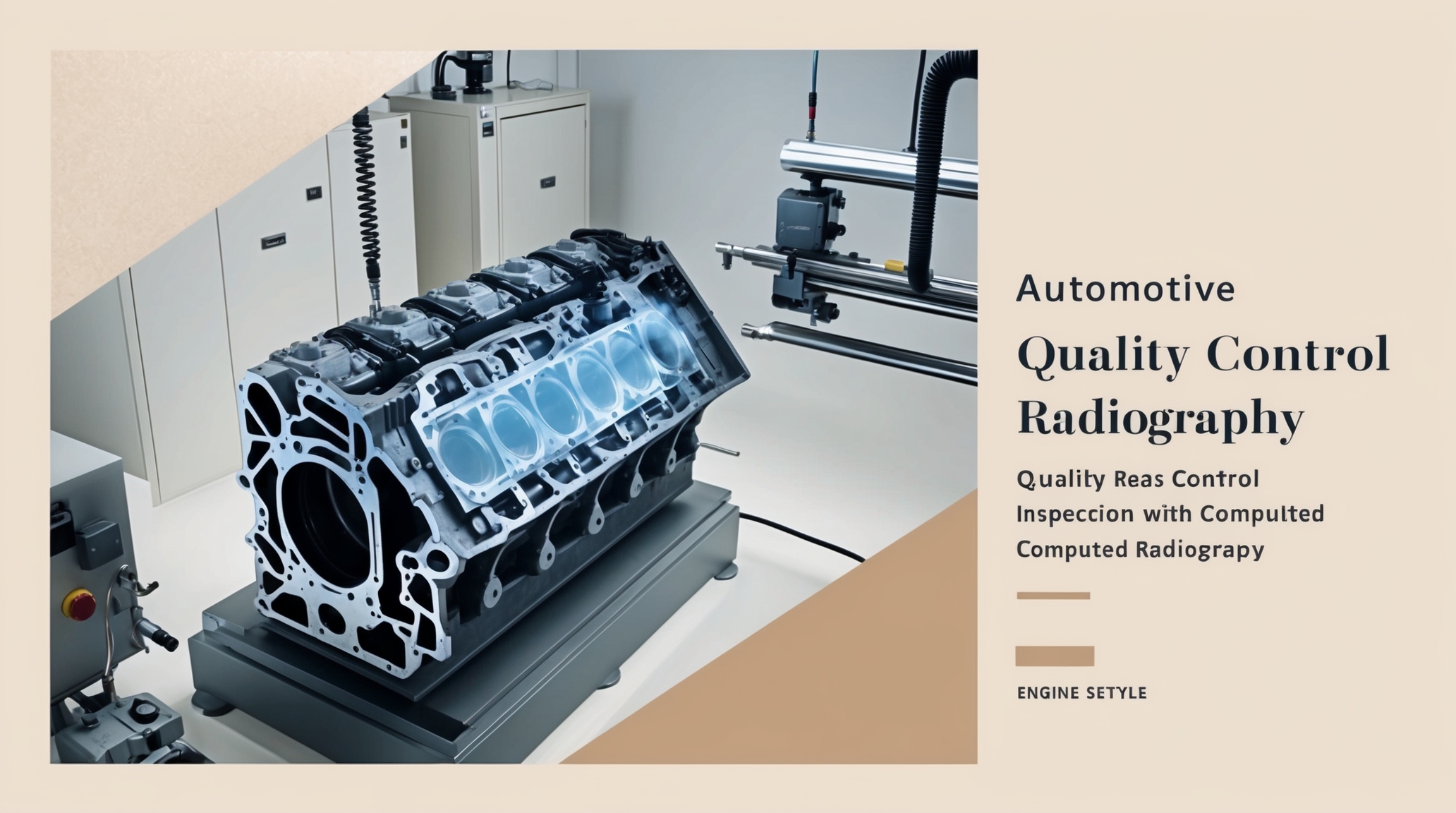April 5, 2025

April 5, 2025
Computerised Radiography (CR) is a modern non-destructive testing (NDT) technique that replaces film radiography with a digital imaging process. Instead of traditional X-ray films, computed radiography (CR) uses imaging plates (IPs) to capture high-resolution images, which are then processed digitally. This enhances inspection speed, defect detection, and overall image quality.
CR radiography is widely used in NDT inspections for welds, pipelines, castings, and aerospace components. It eliminates the need for chemical film processing, making it a cost-effective, eco-friendly, and efficient alternative. Additionally, computer radiography allows for faster image analysis, easy digital storage, and seamless sharing for better decision-making.
The transition from film radiography to computerised radiography is driven by its superior accuracy, reduced operational costs, and improved safety standards. This article explains what CR means, how it works, and its benefits in NDT inspections, helping industries adopt advanced digital testing solutions for better reliability and performance.
Computed Radiography (CR) is an advanced non-destructive testing (NDT) method that replaces film radiography with a digital imaging system. It uses imaging plates (IPs) instead of traditional X-ray films to capture radiographic images. These plates contain photostimulable phosphors, which store X-ray energy and release it as digital signals during scanning. Unlike film-based radiography, CR radiography provides high-resolution images, faster processing, and improved defect detection, making it widely used in industries like aerospace, oil and gas, and manufacturing.

Computerised Radiography
The CR process involves three key steps:
Compared to film radiography, computer radiography eliminates the need for chemical processing, making it a faster, cost-effective, and environmentally friendly solution. CR images can be digitally enhanced, stored, and shared easily, reducing human errors and improving inspection efficiency.
| Feature | Conventional Film Radiography | Computed Radiography |
| Image Capture | Photographic film | Photostimulable phosphor imaging plate |
| Processing | Chemical development in a darkroom | Digital scanning using laser in a CR reader |
| Image Storage | Physical film archive | Digital storage (DICOM, PACS) |
| Reusability | Single-use films | Reusable imaging plates (up to 1000 cycles) |
| Dynamic Range | Narrow | Wide (better contrast across varying densities) |
CR has become a favored method in Non-Destructive Testing (NDT) due to its operational simplicity, high image quality, improved workflow efficiency, and ease of digital archiving and image sharing.
At the core of CR is the Photostimulable Phosphor Plate (PSP) technology, which temporarily stores the radiographic latent image until it is scanned and digitized. Before delving deep into this technology, let’s first look at the key components of Computed Radiography.
The core scientific principle behind CR is photostimulable luminescence (PSL) in a phosphor screen. The process can be divided into four main stages:
The imaging plate (IP) contains a photostimulable phosphor, typically barium Fluorobromide (BaFBr) doped with europium (Eu²)—notated as BaFBr:Eu². This layer has the ability to absorb and store X-ray energy in the form of trapped electrons.
Mechanism
This trapped energy remains stable for hours to days, making it practical for industrial use.
After exposure, the imaging plate is fed into a CR reader unit, which performs the following:
The emitted blue-violet light is collected by optical sensors:
Once digitized, the image undergoes post-processing using specialized software:
After the image is scanned:
Computed Radiography (CR) plays a vital role in Nondestructive Testing (NDT) by providing high-quality digital imaging for industrial inspections. It enhances defect detection, enables real-time assessments, and improves workflow efficiency, making it an essential tool in industries like aerospace, automotive, and infrastructure maintenance.
Computed Radiography allows for precise identification of cracks, porosity, voids, and inclusions in welds, castings, and pipelines. The high-resolution digital images enhance flaw visibility, ensuring accurate defect evaluation. Advanced contrast adjustments and zooming features improve detection capabilities, reducing the risk of structural failures in industrial applications.

Computerised Radiography
Computed Radiography is widely used in aerospace, automotive, and infrastructure industries to inspect critical components without damaging them. It helps assess engine parts, structural frames, and composite materials, ensuring compliance with safety regulations and industry standards. The ability to digitally enhance and analyze images increases inspection reliability.
CR radiography is effective in assessing corrosion, thinning, and material degradation in metal structures, pipelines, and storage tanks. The digital imaging process provides detailed insights into material conditions, helping engineers determine maintenance requirements and prevent costly failures. This improves the longevity and reliability of industrial assets.
CR technology enables real-time analysis of scanned images, reducing downtime in critical operations. The ability to store and transmit images digitally allows for remote assessments, expert consultations, and faster decision-making. This is particularly useful in offshore, hazardous, or hard-to-access locations, improving overall inspection efficiency.
Computed Radiography (CR) revolutionizes Nondestructive Testing (NDT) by offering high-resolution digital imaging for defect detection in industrial components. It enhances inspection speed, reduces environmental impact, improves image quality, and enables easy digital storage and sharing. CR provides a cost-effective, efficient, and reliable alternative to traditional film radiography.
Computed Radiography (CR) enhances defect detection by providing high-resolution digital images of welds, castings, and pipelines. It helps identify cracks, voids, porosity, corrosion, and inclusions with greater accuracy compared to traditional film radiography. Digital image processing also allows for contrast adjustments and zooming, improving defect visibility for precise evaluation.
CR radiography eliminates time-consuming film development by using digital imaging plates (IPs) that are scanned for instant results. This significantly reduces inspection time, allowing for quick decision-making in critical applications like pipeline integrity assessments, aerospace inspections, and manufacturing quality control. Faster processing improves workflow efficiency and minimizes downtime in industrial operations.
Unlike traditional film radiography, which requires chemical processing and hazardous waste disposal, CR radiography is an eco-friendly solution. It eliminates the use of toxic chemicals, reduces material waste, and lowers environmental impact. The reusable imaging plates (IPs) further contribute to sustainability, making CR an environmentally responsible choice for NDT inspections.
Digital CR radiography produces high-contrast, noise-free images with greater dynamic range than traditional film. Advanced image processing tools allow for edge enhancement, contrast adjustments, and noise reduction, improving flaw detection. Inspectors can analyze fine details more effectively, ensuring accurate defect evaluation and reducing the chances of false positives or missed defects.
CR images are stored in digital formats, eliminating the need for physical film storage. Inspectors can easily retrieve, archive, and share images electronically, allowing for remote analysis and collaboration. Digital storage also enables better documentation, traceability, and compliance with industry standards, improving overall inspection efficiency and record management.
While Computed Radiography (CR) offers numerous advantages in Non-destructive Testing (NDT), it also presents certain challenges and limitations. These include initial investment costs, training requirements for operators, sensitivity differences compared to Digital Radiography (DR), potential for equipment damage, and workflow considerations.

Quality Control using computed radiography
Implementing CR systems involves significant initial expenses, encompassing imaging plates, scanners, software, and digital storage solutions. Although CR reduces ongoing costs associated with film and chemical processing, the upfront investment can be substantial, particularly for small and medium-sized enterprises.
Transitioning from traditional film-based radiography to CR necessitates specialized training for operators. Proficiency in digital image acquisition, processing, and interpretation is essential to fully leverage CR's capabilities. Without adequate training, there is a risk of misinterpreting images or mishandling equipment, potentially compromising inspection quality.
CR systems may exhibit lower spatial resolution and sensitivity compared to DR systems. This difference can impact the detection of fine defects, making DR more suitable for applications requiring higher precision. Consequently, industries with stringent quality standards might prefer DR over CR for critical inspections.
CR cassettes and imaging plates are susceptible to damage from mishandling or environmental factors. Scratches, exposure to intense light, or physical impacts can degrade image quality or render the plates unusable. Regular maintenance and careful handling are imperative to preserve equipment longevity and ensure consistent performance.
While CR streamlines certain aspects of the imaging process, it still requires intermediate steps, such as scanning the imaging plates to digitize images. This process can be more time-consuming compared to DR, which offers immediate image acquisition and viewing. In fast-paced environments where time is critical, the additional processing time associated with CR might be a limiting factor.
Understanding these challenges is crucial for organizations to make informed decisions when selecting appropriate radiographic techniques for their specific NDT applications.
The field of Computed Radiography (CR) is experiencing significant advancements, driven by technological innovations and the integration of artificial intelligence (AI). These developments aim to enhance image quality, streamline workflows, and expand the applications of CR in various industries.
Recent progress in imaging plate (IP) technology focuses on improving detector materials and designs to achieve higher resolution and sensitivity. Innovations include the development of direct conversion detectors, which convert X-rays directly into electrical signals, reducing noise and enhancing image clarity. These advancements enable more precise defect detection in critical applications such as aerospace and automotive industries. Additionally, the use of lightweight, portable detectors enhances the flexibility and accessibility of CR systems, facilitating inspections in remote or confined spaces.
The integration of AI into CR systems is revolutionizing defect detection by automating image analysis and interpretation. Machine learning algorithms can be trained to identify patterns and anomalies within radiographic images, improving diagnostic accuracy and reducing the potential for human error. AI-driven tools, such as Generative Adversarial Networks (GANs) and federated learning, enhance defect detection accuracy and enable secure, collaborative model training across industries. This integration not only accelerates the inspection process but also facilitates real-time decision-making, which is crucial in industries where safety and reliability are paramount.
.jpg)
Computed Radiography
Efforts to enhance resolution and expedite scanning processes have led to the adoption of advanced imaging techniques, including phase-contrast radiography and hybrid computed tomography (CT). These methods achieve sub-micron resolution and multi-material analysis, allowing for detailed inspections of complex components. Additionally, the development of portable systems and autonomous robots equipped with AI and quantum X-ray technology is revolutionizing on-site efficiency, paving the way for sub-millisecond defect detection by 2025. These innovations are particularly beneficial in sectors such as infrastructure maintenance and manufacturing, where rapid and accurate inspections are essential.
In summary, the future of Computed Radiography is being shaped by continuous improvements in imaging plate technology, the integration of AI for automated analysis, and the development of high-resolution, fast-scanning techniques. These advancements are poised to enhance the efficacy of non-destructive testing, ensuring higher safety standards and operational efficiency across various industries.
Computed Radiography has significantly transformed non-destructive testing and inspection services by offering a digital, efficient, and environmentally conscious alternative to traditional film-based radiography. Its ability to deliver high-quality images expedites defect detection and analysis, thereby enhancing the reliability and safety of critical components across various industries. The shift towards digital solutions not only streamlines workflows but also aligns with modern environmental standards by reducing chemical waste. As technology progresses, particularly with advancements in imaging plate design and artificial intelligence integration, CR is poised to offer even greater accuracy and efficiency. Embracing these digital innovations is essential for industries aiming to maintain rigorous quality control and safety standards in an increasingly competitive and environmentally conscious market.